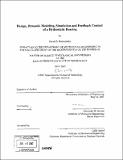| dc.contributor.advisor | Alexander H. Slocum. | en_US |
| dc.contributor.author | Rothenhöfer, Gerald S. (Gerald Sven) | en_US |
| dc.contributor.other | Massachusetts Institute of Technology. Dept. of Mechanical Engineering. | en_US |
| dc.date.accessioned | 2008-01-10T15:51:55Z | |
| dc.date.available | 2008-01-10T15:51:55Z | |
| dc.date.copyright | 2007 | en_US |
| dc.date.issued | 2007 | en_US |
| dc.identifier.uri | http://hdl.handle.net/1721.1/39888 | |
| dc.description | Thesis (S.M.)--Massachusetts Institute of Technology, Dept. of Mechanical Engineering, 2007. | en_US |
| dc.description | Includes bibliographical references (p. 113). | en_US |
| dc.description.abstract | A hydrostatic bearing carriage (Hydrocline) that uses an open face linear motor to drive the carriage as well as to preload the hydrostatic bearings has been developed by Professor Alexander Slocum and Gerald Rothenhöfer of the Massachusetts Institute of Technology's Mechanical Engineering Department. The Hydrocline is made to cope with the increasing requirements for accuracy in silicon wafer grinding machines. The prototype was built of aluminum oxide ceramic due to its high stiffness-to-weight ratio, low thermal expansion and corrosion resistance. In order to keep the cost of manufacturing as low as possible, a modular design that uses micron-level precision ceramic beams was chosen. Initial testing of the prototype carriage indicates that it has the following performance specifications: a vertical load capacity exceeding 5000N (theoretical limit at 12000N, max. pressure of pumps); a carriage pitch error of 0.7arc seconds; a yaw error of 0.7arc seconds; a roll error of +/- 0.6arcsec a vertical straightness at the center of the carriage of +/-0.75microns; and a vertical stiffness of the carriage of 900N per micron (load range from 0 to 1000N). | en_US |
| dc.description.abstract | (cont.) A dynamic model of the hydrostatic bearing and fluid supply system has been developed and accurately predicts the performance of the Hydrocline. The model has been used to simulate a feedback control loop that adjusts the bearing supply flow such that changes in load can be compensated and theoretically infinite stiffness can be reached. In first experiments on a specially designed test setup the measured static stiffness of the single pocket test bearing could be increased by a factor 8 (load range 45 to 270N). The dynamic stiffness of the bearing could be increased by a factor of 2.5. | en_US |
| dc.description.statementofresponsibility | by Gerald S. Rothenhöfer. | en_US |
| dc.format.extent | 113 p. | en_US |
| dc.language.iso | eng | en_US |
| dc.publisher | Massachusetts Institute of Technology | en_US |
| dc.rights | M.I.T. theses are protected by copyright. They may be viewed from this source for any purpose, but reproduction or distribution in any format is prohibited without written permission. See provided URL for inquiries about permission. | en_US |
| dc.rights.uri | http://dspace.mit.edu/handle/1721.1/7582 | |
| dc.subject | Mechanical Engineering. | en_US |
| dc.title | Design, dynamic modeling, simulation and feedback control of hydrostatic bearing | en_US |
| dc.type | Thesis | en_US |
| dc.description.degree | S.M. | en_US |
| dc.contributor.department | Massachusetts Institute of Technology. Department of Mechanical Engineering | |
| dc.identifier.oclc | 182540463 | en_US |
